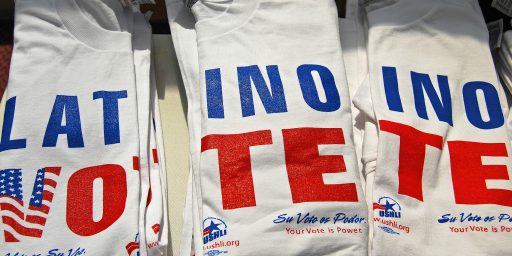New York City Voters Approve Ranked-Choice Voting
A big win for ranked-choice voting in the Big Apple as voters approve a referendum that will bring ranked-choice voting to the nation's most populous city.

In addition to the results from Mississippi, Kentucky, and Virginia, among the more interesting results from yesterday’s election comes out of New York City where voters approved a referendum that will establish ranked-choice voting for elections in the city, making it one of the largest jurisdictions in the country to adopt the practice:
New York City will move to a system of ranked-choice voting, shaking up the way its elections are run after voters approved a ballot question to make the change.
The city will be by far the biggest place in the U.S. to put the new way of voting to the test, tripling the number of people around the country who use it.
A ballot question proposing the shift for New York primaries and special elections was approved Tuesday by a margin of nearly 3-1.
It’s now set to be in effect for New York’s elections for mayor, City Council and other offices in 2021.
Under the system, voters will rank up to five candidates in order of preference, instead of casting a ballot for just one.
If no candidate gets a majority of the vote, the last place candidate is eliminated and their votes are parceled out to the voter’s second choice, a computerized process that continues until one candidate has a majority and is declared the winner.
Ranked-choice voting is now in use or approved in 18 other cities around the country, including San Francisco, Minneapolis and Cambridge. The state of Maine also uses it.
Backers say the system discourages negative campaigning, and forces candidates to reach out to more voters rather than relying on a narrow base. It’s also designed to allow voters to pick their true favorite, without worrying about throwing away a vote on someone who can’t win.
“You’ve got to be, I think, a better candidate,” said FairVote President Rob Richie.
“You as a candidate have a lot more reasons to have conversations and engagements with people,” he said. “The candidates that run traditional campaigns that involve using money and not using people have not done as well.”
The plan will eliminate New York’s traditional runoff elections, which are held for citywide offices if no candidate cracks 40 percent of the vote. The Independent Budget Office estimated that that could save $20 million for each election cycle that would require a runoff.
But with the city Board of Elections already known for frequent fumbles, it could result in much longer waits for New Yorkers to find out who has won a primary.
In cities where ranked choice has been tried, it has sometimes resulted in unorthodox campaign tactics like multiple candidates banding together into alliances with competitors to jockey for second and third place votes.
In the final weeks of the campaign, the referendum came under criticism from some African-American and Latino voting rights advocates who appeared to fear that it would work to the detriment of minority candidates, but actual studies of jurisdictions where it has been used have found exactly the opposite:
[I[n the closing days of the campaign, opposition emerged from the City Council’s Black, Latino and Asian Caucus, which said the change could hurt the chances of candidates of color.
“Our communities of color have flexed their considerable muscle at the ballot box over the last decade by electing the first Asian and black female citywide officials as well as a racially and ethnically diverse majority of the City Council’s membership. Yet some critics have suggested that those historic victories were ‘anti-Democratic’ because they were not decided by a majority of voters,” the group said in a statement.
“These outsiders know nothing about our communities and what is in their interest even less. With the next round of municipal elections two years away, if Ranked Choice Voting is adopted, it would dilute the electoral power of communities of color, and diminish black, Latino and Asian candidacies by offering a ‘traditional’ candidate as a ‘safe’ alternative to voters,” the caucus said.
A study by FairVote found that in California’s Bay Area, candidates of color won 62 percent of ranked-choice races, compared to 38 percent before the switch.
But research by Craig Burnett, an associate professor of political science at Hofstra University, found that voters in black and Latino neighborhoods in San Francisco and Oakland are more likely to choose just one candidate and leave the rest of the ballot blank, whereas voters in white neighborhoods are more likely to maximize their influence by completing the ballot.
An extensive voter education effort will be needed before the switch goes into effect, Burnett said
“They’ll be changing decades worth of history here, and some people will get it very easily, and some people won’t,” he said. “For a lot of voters who don’t have experience with this, who aren’t paying very careful attention, it’s going to be confusing.”
While the concerns about voter confusion and the impact that could have on the outcome of elections, ranked-choice voting is really quite simple to understand At the ballot box, voters are given a list of the candidates who have qualified for the ballot and is asked to rank them from first to last in terms of who they prefer. In order to win a race under the system as Maine has adopted it, which is largely similar to what has been proposed by political scientists who have written on the subject, a candidate needs to get a majority of the vote rather than just a plurality of the vote that makes it possible to win in most states. What happens next is essentially similar to a runoff election, except it gets conducted instantly rather than requiring another election weeks later. The candidate with the fewest top-ranked votes is eliminated and the votes that candidate received are given to whichever candidate the voter ranked as second. The process continues until one candidate has a majority of the vote, a process that could take one round or could take several rounds. This process can be done manually, of course, but the more convenient way would leave it to a computer to do the calculation necessary to determine a winner, with a means for human beings to check it by hand should any objections be made.
Advocates for ranked-choice voting, sometimes also called “instant-runoff voting,” say that this form of voting forces candidates to reach out to a broader group of voters than they might have under a system where a candidate can win with a plurality of votes and that it also gives voters the opportunity to give support to candidates beyond the “mainstream” choices or the candidates that happen to have the loudest voices and the most money. Additionally, advocates contend that running for office in a ranked-choice system makes it more difficult for candidates who focus mostly on appealing to their hardcore base and on attacking their opponents. This is because they argue, it is far riskier to run negative campaigns against your opponents when you potentially may have to appeal to at least some of their supporters to rank you second or third in order to get you to the 50-percent-plus-one needed to win the election. Finally, it is hoped that such a system will lead to candidates more willing to compromise to get legislation passed and to govern in general. Whether all of this works out the way advocates hope remains to be seen, but it seems clear that it’s worth giving it a try.
As noted, ranked-choice voting is already in place in a number of major American cities, as well as the State of Maine. So far, there have been few complaints about the process and voters in each of these jurisdictions have appeared to get used to the system once it has been adequately explained to them. It may take an election or two to work all the bugs out of the system in a jurisdiction as populated as New York City but I’m sure that voters will adapt to it there just as they have elsewhere.
For advocates of voting reform, this is a positive development simply because the Big Apple will be the most heavily-populated jurisdiction to adopt ranked-choice voting and because it could lead neighboring jurisdictions, such as New York state and New Jersey, to move to a similar system. From there, it would hopefully be looked at by other jurisdictions, including perhaps even some Republican-held states. The biggest prize of all, of course, would be California but efforts to adopt the system there hit a roadblock when a bill that would have adopted such a system for the Golden State was vetoed by Governor Gavin Newsom, who had also opposed the idea when he was a San Francisco politician back in 2002. It’s possible that the state legislature might override the veto, or that the bill could be put foward again in the future. Newsome claims to oppose the bill due to the possibility of “voter confusion,”





I really don’t buy this. One, it is not that voters are that informed when they go into voting booth anyway. I always find it astounding that people are looking at the ballot for the first time as they are standing in line. Sure, they know the top of the tickets but that is usually about it. Many don’t come prepared for down ballot candidates or referenda or constitutional amendments.
Two, people adjust very quickly. Yes, it may take an election or two to get used to ranked choice.
But guess what, if implemented five years from now, it will still take an election or two anyhow.
To me, having a state and several cities adopt it is good because it can then be widely evaluated. Just like states (like Oregon) implementing all mail balloting. Or limited electronic transmission of absentee voting. Some countries (like Estonia) have internet voting. It can be done. It needs a will and a public confidence. And small scale demonstrations.
I think a good solution to the gerrymandering problem would be to replace geographically defined districts with a single transferable vote ranked choice system.
The “voter confusion” defense remains stupid whether it’s being used by a Republican or a Democrat.
Any jurisdiction that requires a winner to have minimum percentage of the votes cast with a runoff, should use ranked-choice voting. Potentially it has the benefit of encouraging alternative parties to the Dems and Rethugs. While that won’t effect national elections, it could on the local level. There is a lot of pearl clutching around the need for a national centrist party and that won’t happen starting with national elections. But over a few cycles we could see the development of state level centrist parties that could band together and be a force on the national level.
If there are 5 candidates, do you have to rank all five, or just the ones you can stand?
Example, if the ballot features Clinton, Johnson, Stein, Nader, and Trump, can you simply rank, say Clinton as first, Johnson as second, and no one else?
I’m pretty sure the answer is no.
@Kathy: ranked-choice voting can be done either way. If, for instance, you only vote for two people, and neither of them win, your vote just doesn’t count.
@Teve:
That’s how confusion can wreak havoc. Faced with the choices I outlined above, I’d not want to rate trump at all. let’s face it, last is way to high for him. But if the ballot requires rating all choices, then there’s no choice but to do so.
Several years ago ranked choice was voted in for the county I live in. You only ranked the ones you wanted to. If all your ranked candidates were eliminated before someone got to 50% you effectively voted for no one on that specific election.
Unfortunately both major parties spent the next 2 years trashing it with the same tired “it’s confusing” arguments and spent a ton of money, and it was voted back out the next off-cycle election. Still PO’ed about that.
@Just Another Ex-Republican:
Someone should have challenged the removal vote for not including a ranked choice between “Yes”, “No”, and “Maybe”
@Kathy: my math instinct says ranking him last is equivalent to not voting for him, but I haven’t sat down and worked it out.
@Teve:
Done properly, your ballot counts toward the denominator that establishes how many votes the winner needs to get in the end, even if it doesn’t count in the numerator for any candidate. Elections that result in no candidate ending up with a majority even after ranked preferences have been accounted for should result in starting over.
@DrDaveT: or you could reduce the denominator if the only selections a voter made were all eliminated, on the basis that it’s equivalent to a runoff election in which that person didn’t care enough to show for either candidate remaining.
@Kathy: You’re rating everyone you don’t vote for as last. The difference between RCV and FPTP is just that you can rate more than “one at first, tie everyone else at last”. You’ve never been able to vote -1 for a candidate.
I wonder if Democrats would allow a “None of the above” ranking?